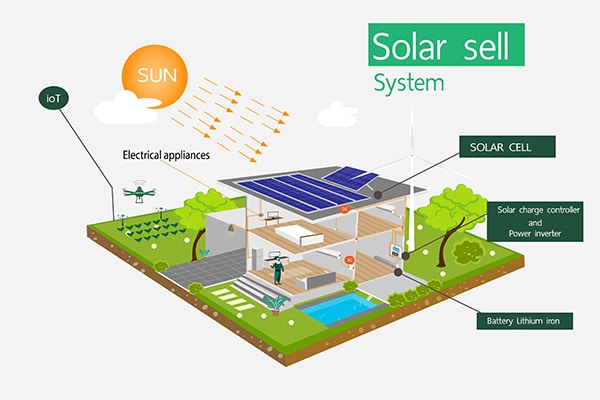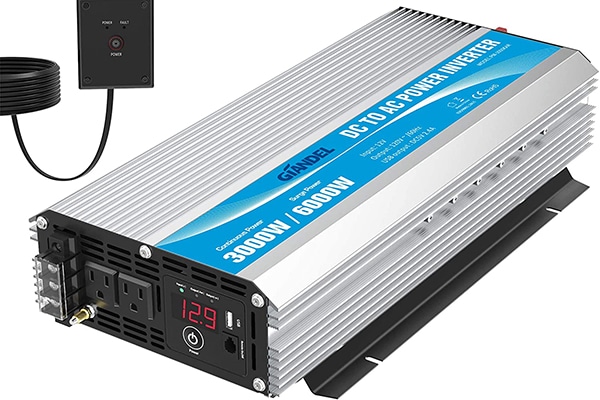Power inverters allow you to convert Direct Current (DC) from batteries to Alternating Current (AC) used by devices and appliances. One of the most common inverters on the market is the 1500 Watt Power Inverter.
If you’re in the market for a 1500W Inverter, you have many models to sort through. I have reviewed 1500 models available on the market now and would like to provide an overview of some of the best choices.
Table of contents
Types of 1500W Inverters
Inverters can be divided into several categories, so the choice is not always straightforward.
This article focuses on off-grid inverters.
There are 3 major categories of inverters, and each main category comes in 3 main input voltages and 2 main output voltages.
If you already know this, you can jump down to the selection below, but continue reading if you would like more information.
This is a list of your primary inverter categories to consider.
- Input Voltage – 12V, 24V, 36V, 48V
- Output Voltage – 110/120V or 220/240V
- Waveform – Pure Sinewave or Modified Sinewave
- Design – Low-Frequency Pure sinewave or High-Frequency Pure sinewave
- Functionality – Inverter or Inverter Charger.
Input Voltage
You will probably use a battery bank, so your inverter’s input voltage should match the nominal battery voltage – probably 12V, 24V, or 48V.
Once you have done this you can select the desired AC output voltage (120 or 240 VAC).
Output Voltage
Knowing the output voltage needs of your inverter is important – 110/120V or 220/240V.
When determining your output voltage, although most appliances and electronics use 120V, pumps often use 240V.
Waveform

This article discusses two primary types of waveform inverters – Sine Wave (Pure/True) and Modified Sine Wave.
Sine Wave (Pure/True) – This inverter uses AC – the type provided by your local utility company. This is much better for more sensitive appliances and devices.
Pure Sine Wave inverters are also more expensive.
Modified Sine Wave – Rougher and less efficient is how best to describe this inverter. Some appliances and devices won’t work with a Modified Sine Wave inverter. They are often used for tools and basic appliances.
High-Frequency Pure Sine Wave
These inverters are usually less expensive, smaller, and don’t handle industrial loads as well as a low-frequency inverter. They are more common in retail sales.
High-frequency inverters are appropriate for many small appliances and devices but don’t work well long-term with high-torque tools, pumps, and motors.
High-frequency inverters are typically fine for the occasional user – camping, car camping, RV’s, boating, etc., if you are only using them a few hours a week. They are also fine for small electronic devices used a few hours a day.
Low-Frequency Pure Sine Wave
These inverters have large iron cores, which make them much larger and very durable. Low-frequency inverters operate much cooler and offer many features.
Multiple DC inputs are often allowed, along with dual voltage outputs (120/240V).
If you are going to run compressors and air-conditioners, then consider low-frequency inverters. They are also appropriate if running equipment regularly and for long periods of time.
What Can a 1500W Inverter Run?

A 1500 watt inverter can run equipment or devices with a running power consumption of fewer than 1500 watts.
Running power is the power used consistently after the initial surge.
There are a few things to keep in mind.
- Add up the watts being use – ie., light =60W + fridge=1,000W + TV=440W = 1500W
- Surge or starting power consumption should be about 2-3x the running power consumption. Appliances with motors typically require a brief surge of power to start.
- Total power consumption should not exceed 1500. You will need to turn off devices if it does.
Criteria for Choosing Your Power Inverter
Below are a few features to consider when choosing your inverter.
Rating
Planning is important. Make sure you determine the watts you will need, and don’t be too conservative. Use the actual number of watts your electronics and appliances use.
Noise
Inverters use fans. It is no fun to listen to these in a tight environment like your truck, RV, or boat. Check out the reviews, as these will often mention if they are noisy or not.
Number of Power Outlets
Power inverters are available with single outlets to power one device and multiple outlets to power multiple devices simultaneously. Make sure you consider your needs before making the purchase.
Number of USB Ports
Many power inverters come with Universal Serial Bus (USB) ports, allowing you to charge your cell phones, laptops, game consoles, power tools, and other electronics. They come in conjunction with the power outlets. Make sure you check how many are available.
Safety Features
Some inverters incorporate safety features to shut down the inverter at high temperatures, surge protectors, etc. There are many others, so review them and decide what you need. Inverters are not inexpensive.
Size
Size often depends on where you are using your inverter. In a vehicle or where portability is important, it makes more sense to use a high-frequency inverter.
If you are powering your home or job site daily and for long hours, it may make more sense to use a low-frequency inverter.
A Few Items to Keep in Mind
- Remote Starter does not mean you can wander around with it like your TV. Many of them are wired and only extend about 15 feet, so make sure you check the specifications.
- No LCD Display does not mean no LED display, so check the specifications for these.
Input – 12V, Output – 110/120V
Best 1500 Watt MODIFIED Sine Wave Inverters
Best 1500W PURE Sine Wave Inverters
1500W Modified Sine Wave Inverters – Pros & Cons
Pros
- 2x 110V AC Outlets
- Quiet inverter fans
- LDC Display – wattage, input voltage, battery level, warning indicators
- Installation Kit – fuse, cables, wires
Cons
- Less AC outlets than some other similar inverters
- Rougher power than Pure Sine inverters
- Not suited for sensitive equipment
Pros
- USB Ports are 2.4A, and you can plug in an iPad or iPhone directly
- Easy to read LCD and LED monitoring
- Also has a very quiet fan
- Installation Kit – fuse, cables, wires
Cons
- In the installation kit, only cables
- Rougher power than Pure Sine inverters
- Not suited for sensitive equipment
- Some complaints about USB ports not working
Pros
- Remote Starter
- 3 AC outlets and 1 USB port which makes more sense in a modified sine wave
- Multiple safety features – overload protection, over-voltage, thermal, etc.
- Installation Kit – fuse, cables, wires
Cons
- No installation kit
- Some complaints about fan noise
- Unit a little larger than some competitors
- Some complaints about USB ports not working
- Included cables too thin
Giandel 1600Watt Power Inverter Modified Wave DC 12volt
Pros
- Remote Starter
- Good price
- LED Display with multiple safety protections – voltage, short circuit, over-heating, etc.
- A smart cooling fan that only comes on over 104 degrees.
Cons
- No installation kit
- A little on the bulky side compared to competitors
- It’s not easy to anchor. It would be nice to have some type of mounting brackets
1500W Pure Sine Wave Inverters – Pros & Cons
VertaMax 1500W 12V Pure Sine Wave InverterPros
- Very quiet inverter
- Good price
- A quality inverter that is well-made
- Good inverter for OTR drivers
Cons
- Some complaints about remote starter not working.
- No USB ports
- Complaints about the watt meter not working.
AIMS 1500W 12V Pure Sine Wave Inverter
Pros
- Service and technical support here in the US
- Long-standing company with a solid reputation and good customer service
- The longest warranty at 2 years
- Dual cooling fans
Cons
- No cables included
- No remote starter but it is optional
- No screw eyelets to easily mount
Voltworks 1500W 12V Pure Sine Wave Inverter
Pros
- Good features with everything you need but the starter kit
- Remote on/off switch and not just a reset button
- Very quiet inverter
Cons
- Very hard to find surge information and even the site says not to use anything with a surge.
- Fragile USB port
- Can’t manually turn off the low-voltage alarm
Pros
- Positive feedback on the ability of this inverter to handle spike wattage surges
- No issues with the remote switch breaking like some other inverters
Cons
- Cables that come with the battery are insufficient and underrated. Get your own.
- Some feedback on the difficulty in contacting customer support
- The inverter is a little bulky in size
Related Articles
SolarKnowHow uses affiliate links on this website. When you buy through links on this website, I receive a small commission at no additional cost to you. If you find this review helpful, please consider making your purchase through one of these links. Thank you




